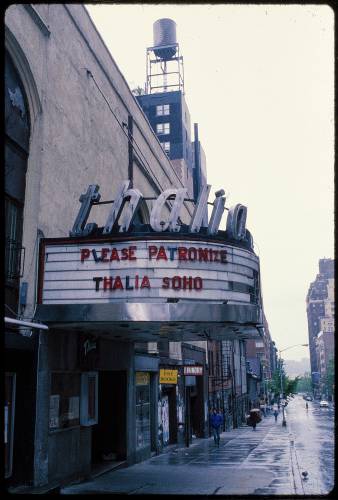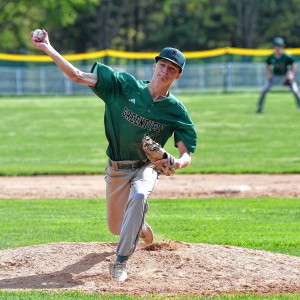My Turn: Spending quality time in the dark

The Thalia Theater on Manhattan's Upper West Side, seen between 1970 and 1990. It was gutted and incorporated into Symphony Space in 1990 as the Leonard Nimoy Thalia. The photo that originally ran with this article was of The Thalia Theatre on the Lower East Side Of Manhattan, known as the Bowery Theatre, which burned down in 1929. VIA LIBRARY OF CONGRESS
|
Published: 03-20-2024 6:19 PM
Modified: 03-21-2024 11:08 AM |
November is the month for elections, and Nov. 5 promises to be a dramatic day — but March is the month of cinema and contention over who has produced the best work the public will come sit for hours in the dark to see. The Academy Awards ceremony began in 1929, as a means to promote film as an art form, with an attendees dinner priced at a whopping $5.
As a child, I made Saturday walks to watch low-budget westerns. Later, Saturday night family outings were to double features. The movies were my focus in Hollywood’s Golden Age: “Showboat” (1950), “Marty,” “Bridge On the River Kwai,” “South Pacific,” “North By Northwest,” “Casablanca,” “Citizen Kane,” “Dial M for Murder,” “Singin’ in the Rain,” “Vertigo,” “Rear Window,” “12 Angry Men,” and more.
Ohio State University had a Films Classics Club with introduction to the comedies of Charlie Chaplin, Buster Keaton and the Marx Brothers, playing of “The Great Train Robbery” (1903), Russian director Sergei Eisenstein’s powerful “Battleship Potemkin”; “20,000 Leagues Under the Sea”; “The Passion of Joan of Arc”; “The Last of the Mohicans”; “Greed”; Pare Lorentz’s great 1937 documentary “The River”; Metropolis”; the best rendering of World War I, “All Quiet on the Western Front”; “The Cabinet of Dr. Caligari”; Robert Flaherty’s extraordinary 1922 Arctic drama “Nanook of the North”; D. W. Griffith’s racist “Birth of a Nation” that President Wilson notoriously championed with a showing at the White House.
Victor Sjostrom inspired Ingmar Bergman with “The Phantom Carriage” in 1921. He played the lead in Bergman’s revered “Wild Strawberries.”
When I came to teach in New York, I lived a block from the famous Thalia, which screened only classic film double features. One changed each day. By attending every other day, I’d see them all. What ran were classics from Europe — “Grand Illusion,” “Tomorrow is My Turn,” “The 400 Blows,” “Kanal.” “Ashes and Diamonds,” “Knife in the Water,” “Closely Watched Trains,” “The Fireman’s Ball,” Alec Guiness’s “Lavender Hill Mob,” Marcel Pagnol’s wonderful 1930s trilogy, “Marius, Fanny,” and “Cesar,” “The Rules of the Game,” “Diary of a Country Priest,” “The Lower Depths,” “Children of Paradise,” the Beatles’ “Hard Days Night,” “Brief Encounter,” “Monsieur Hulot’s Holiday,” and Jean Vigo’s “L’Atalante.”
For film enthusiasts, Martin Scorsese’s “My Voyage to Italy” is a wealthy assembly of the treasured films from Italy. Many of these films mentioned can be found and watched online. If I’ve neglected to name your favorite, it’s for lack of space.
Stan Brakage, Kenneth Anger, Maya Daren, Ed Emshwiller, Jonas Mekas and others were producing experimental films. I did film study at City College, acquired a Rolex and Angenieux lens, did camera for In Time shown at New York’s Museum of Modern Art, and soon had a contract to film a successful Peace Corps project in the altiplano of Peru. Near Lake Titicaca, volunteers were aiding Aymara people to create a cooperative to sell their artwork.
A partner and I cast 20-year-old Robert De Niro, before he went to Hollywood, in my short film, “I Wish You a Happy Ending.” My partner backed out. The film was never produced. I settled back into teaching. Later, as an independent print and video journalist, I did make several dozen documentaries.
Article continues after...
Yesterday's Most Read Articles
 Retired police officer, veteran opens firearms training academy in Millers Falls
Retired police officer, veteran opens firearms training academy in Millers Falls
 Valley lawmakers seek shorter license for FirstLight hydropower projects
Valley lawmakers seek shorter license for FirstLight hydropower projects
 More than 130 arrested at pro-Palestinian protest at UMass
More than 130 arrested at pro-Palestinian protest at UMass
 Baseball: Caleb Thomas pitches Greenfield to first win over Frontier since 2019 (PHOTOS)
Baseball: Caleb Thomas pitches Greenfield to first win over Frontier since 2019 (PHOTOS)
 Real Estate Transactions: May 10, 2024
Real Estate Transactions: May 10, 2024
 As I See It: Between Israel and Palestine: Which side should we be on, and why?
As I See It: Between Israel and Palestine: Which side should we be on, and why?
After the war, Japan offered excellent cinema — “Rashomon,” “Ikiru,” “Seven Samurai,” “Ugetsu,” and “Woman in the Dunes.” There are treasured films coming from Iran, Turkey, Romania, and beyond — “Separation,” “Winter Sleep,” “The Death of Mr. Lazarescu.”
I’ve enjoyed Oscar-nominated American fiction, but suffered through both “Maestro,” because the characters smoke in every scene, and “Oppenheimer,” because the venue had no more respect for audience than to run an hour of commercials before the long feature.
Finally, I offer my list of films not to be missed — “Sophie’s Choice,” “Scent of a Woman,” “The Sheltering Sky,” “Mrs. Doubtfire,” “Long Day’s Journey Into Night,” “Elling,” “Nothing But a Man,” “Waterland,” “Sawdust and Tinsel,” “Wildrose,” “Stolen Children” (Il ladro di bambini), “East of Eden,” “The Harder They Come,” “JFK,” “Remains of the Day,” “Billy Budd,” “Five Easy Pieces,” “Great Expectations,” “Grapes of Wrath,” “No Country for Old Men,” “The Seventh Seal,” and “Jesus of Montreal.”
My own 22 best are “Modern Times,” “The Circus,” Keaton’s “The General,” “Wild Strawberries,” “Ladykillers,” “Thing’s Change,” “August,” “Osage County,” “Tin Men,” “Tampopo,” “The Gin Game,” “La Strada,” “Cool Hand Luke,” “Amadeus,” “The Godfather,” “The Grey Fox,” “The English Patient,” “Black Orpheus,” 8 1/2,” “Treasure of Sierra Madre,” “One Flew Over the Cuckoo’s Nest,” “Zorba the Greek,” and “Down By Law.”
Charlemont resident Carl Doerner is an author and historian, currently editing his new work, “Breaking the Silence: Revisioning the American Narrative.”

 My Turn: No good answers with utilities in control
My Turn: No good answers with utilities in control My Turn: Blame Hamas for the suffering of Palestinians
My Turn: Blame Hamas for the suffering of Palestinians Ahmad Esfahani: Democratic lagging
Ahmad Esfahani: Democratic lagging Evlyn Ashong-Katai: Back tax fund for elderly, disabled
Evlyn Ashong-Katai: Back tax fund for elderly, disabled
